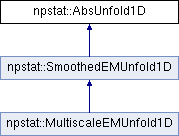Public Member Functions |
Static Public Member Functions |
Protected Member Functions |
Static Protected Member Functions |
List of all members
npstat::AbsUnfold1D Class Referenceabstract
Inheritance diagram for npstat::AbsUnfold1D:

Constructor & Destructor Documentation◆ AbsUnfold1D()
Number of rows of the response matrix should be equal to the number of discretization intervals in the space of observations. Number of columns should be equal to the number of intervals in the original (unfolded) space. Member Function Documentation◆ clearInitialApproximation()
Clear the initial approximation to the unfolded solution ◆ getFilter()
Retrieve the smoothing filter used ◆ getInitialApproximation()
Return the initial approximation to the unfolded solution ◆ modelNDoF()
Effective number of degrees of freedom for the smearing model (for use in AIC, etc). Will call "unfold" internally, so can't be a const method. ◆ observationCovariance()
Procedure for building covariance matrix of observations according to either Poisson or multinomial distribution ◆ probDelta()
An L1-like relative distance between two unnormalized density-like arrays. Can be used as a convergence measure. ◆ setFilter()
Set the smoothing filter used. The filter will not be copied. It is the responsibility of the user of this class to ensure that the lifetime of the filter exceeds the lifetime of this object. ◆ setInitialApproximation()
Set the initial approximation to the unfolded solution ◆ smoothingNDoF()
The first element of the pair is the entropic nDoF and the second is the nDoF based on the trace ◆ unfold()
Method to be implemented by derived classes. "lenObserved" and "lenUnfolded" should be consistent with the dimensionality of the response matrix provided in the constructor. The "observationCovarianceMatrix" pointer to the covariance matrix of observations can be NULL in which case this covariance matrix will be evaluated internally (typically, assuming either Poisson or multinomial distributions for the observed counts). "unfoldedCovarianceMatrix" pointer, if not NULL, should be used to return the covariance matrix of unfolded values with dimensions (lenUnfolded x lenUnfolded). This function should return "true" on success and "false" on failure. Implemented in npstat::SmoothedEMUnfold1D. ◆ useConvolutions()
Switch between using filtering or convolution ◆ usingConvolutions()
Check if the filter should use "filter" or "convolve" method The documentation for this class was generated from the following file:
Generated by |
||||||||||||||||||||||||||||||||||||||||||||||||||||||||||||||||||||||||||||||||||||||||||||||||||||||||||||||||||||||||||||||||||||||||||||||||||||||||||||||||||||||||||||||||||||||||||||||||||||||||||||||||||||||||||||||||||